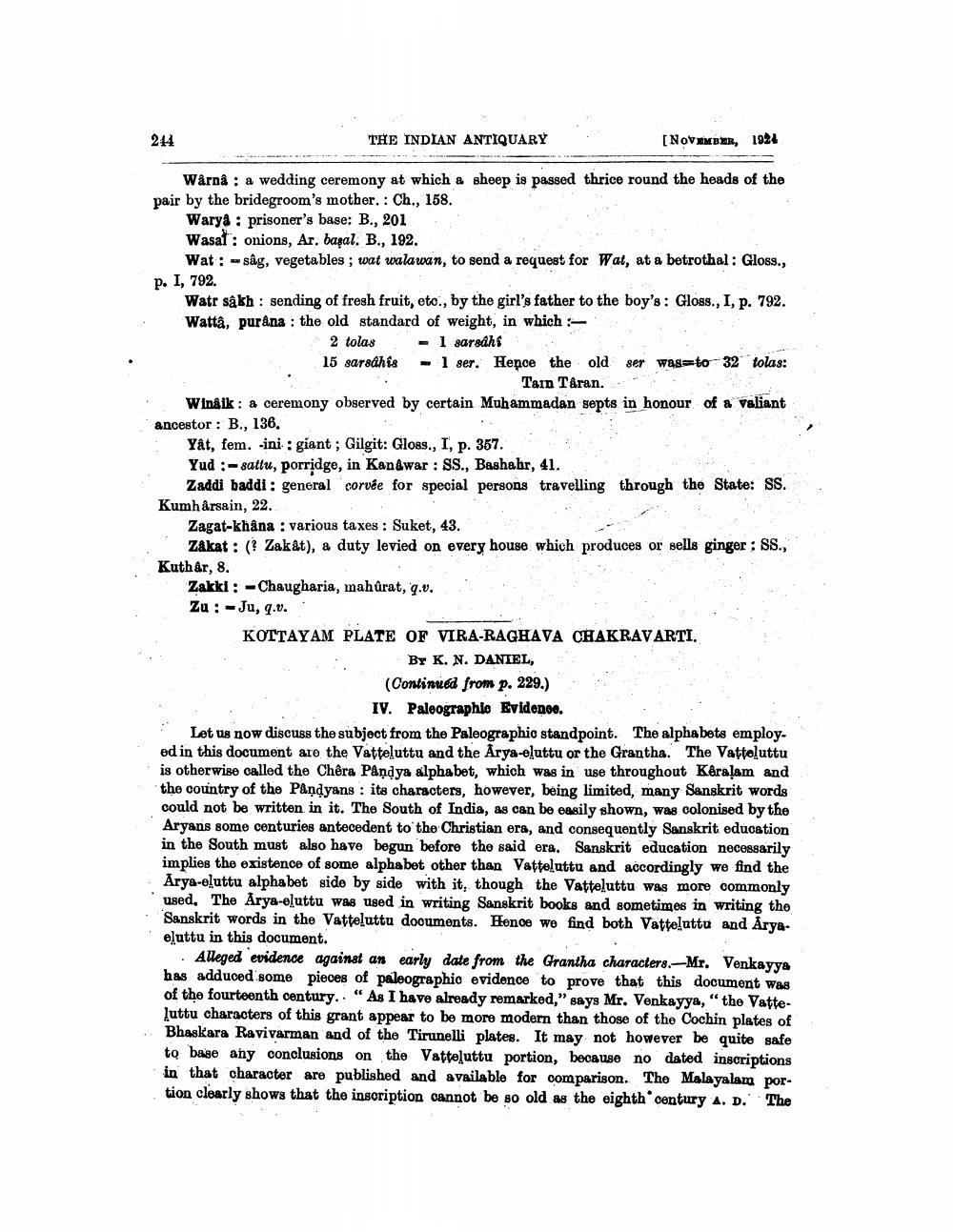________________
244
THE INDIAN ANTIQUARY
[NOVEMBER, 1924
Warnâ a wedding ceremony at which a sheep is passed thrice round the heads of the pair by the bridegroom's mother. Ch., 158.
Warya prisoner's base: B., 201
Wasal: onions, Ar. bagal. B., 192.
Wat såg, vegetables; wat walawan, to send a request for Wat, at a betrothal: Gloss., p. I, 792.
Watr sâkh: sending of fresh fruit, etc., by the girl's father to the boy's: Gloss., I, p. 792. Wattâ, purana: the old standard of weight, in which :
2 tolas 15 sarsâhîs
- 1 sarsâhî
- 1 ser. Hence the old ser was to 32 tolas: Tain Târan.
Winâik: a ceremony observed by certain Muhammadan septs in honour of a valiant ancestor B., 136,
:
Yât, fem. -ini: giant; Gilgit: Gloss., I, p. 357.
Yud-sattu, porridge, in Kanawar : SS., Bashahr, 41.
Zaddi baddi general corvée for special persons travelling through the State: SS. Kumhârsain, 22.
Zagat-khâna: various taxes: Suket, 43.
Zakat: (? Zakât), a duty levied on every house which produces or sells ginger: SS., Kuthar, 8.
Zakki: -Chaugharia, mahûrat, q.v.
Zu: Ju, q.v.
KOTTAYAM PLATE OF VIRA-RAGHAVA CHAKRAVARTI.
By K. N. DANIEL,
(Continued from p. 229.)
IV. Paleographic Evidence.
Let us now discuss the subject from the Paleographic standpoint. The alphabets employed in this document are the Vatteluttu and the Arya-eluttu or the Grantha. The Vatteluttu is otherwise called the Chêra Pandya alphabet, which was in use throughout Kêralam and the country of the Pandyans: its characters, however, being limited, many Sanskrit words could not be written in it. The South of India, as can be easily shown, was colonised by the Aryans some centuries antecedent to the Christian era, and consequently Sanskrit education in the South must also have begun before the said era. Sanskrit education necessarily implies the existence of some alphabet other than Vatteluttu and accordingly we find the Arya-eluttu alphabet side by side with it, though the Vatteluttu was more commonly used. The Arya-eluttu was used in writing Sanskrit books and sometimes in writing the Sanskrit words in the Vatteluttu documents. Hence we find both Vatteluttu and Arya
eluttu in this document.
Alleged evidence against an early date from the Grantha characters.-Mr. Venkayya has adduced some pieces of paleographic evidence to prove that this document was of the fourteenth century.. "As I have already remarked," says Mr. Venkayya, "the Vatteluttu characters of this grant appear to be more modern than those of the Cochin plates of Bhaskara Ravivarman and of the Tirunelli plates. It may not however be quite safe to base any conclusions on the Vatteluttu portion, because no dated inscriptions in that character are published and available for comparison. The Malayalam portion clearly shows that the inscription cannot be so old as the eighth century A. D. The




